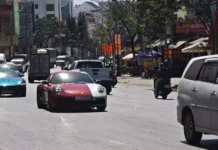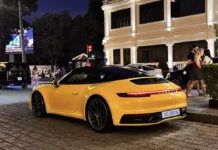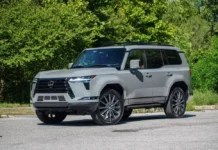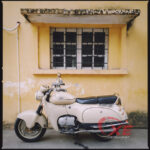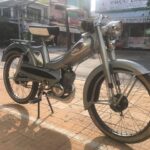Bicycles and motorbikes were the most common means of transportation in the southern region of Vietnam before 1975 and until now. This article provides a comprehensive overview of the motorbikes that were present in the southern region before 1975.
>> You can comment on this article at http://www.facebook.com/Autodaily
Mobylette, Vélosolex – French elegance
When it comes to motorbikes, everyone who used to live in the southern region of Vietnam is familiar with Mobylette. Since Vietnam was a French colony, Mobylette bikes were very popular on the streets. Mobylette bikes were manufactured by Motobécane, but many people knew them by the name Mobylette rather than Motobécane.
In Vietnam, there were two types of Mobylette bikes: yellow Mobylette and blue Mobylette. Both used a 49.99cc engine and were classified as vélomoteur, which did not require a driver’s license. The small yellow Mobylette had only a front suspension fork, while the larger blue Mobylette had suspension forks both at the front and rear, making it smoother to ride and more expensive.
Mobylette bikes haven’t changed much over the years. In the 1950s, they had a tube frame. In the 1960s, the frame was made of stamped metal. The color also changed occasionally, with the yellow Mobylette being replaced by a gray one. Mobylette bikes were designed to be easy to use. They didn’t require gear shifting and used automatic clutch. Turning the throttle would make the bike go faster or slower. Starting the engine was as simple as pedaling fast. If pedaling didn’t start the engine, moving a latch near the rear wheel, which was connected to the engine, would separate the engine from the rear wheel, allowing the bike to be pushed home.
 A corner of Saigon with Solex, Vespa, Mobylette, Honda…
A corner of Saigon with Solex, Vespa, Mobylette, Honda…
If you’ve ever been riding a bicycle and thought about attaching a small engine to it so you don’t have to pedal, someone has already thought of that and created the Vélosolex. The Vélosolex is a bicycle with an engine attached to the front wheel. The engine rolls a round stone-like object underneath. When the rider pulls the front lever, the stone-like object lifts off the front wheel, allowing the bike to be pedaled like a regular bicycle. When pedaling reaches a certain speed, lowering the lever engages the engine, which then powers the bike with the front wheel. Once the bike is running smoothly, the rider can lift their feet to the middle platform for a comfortable seating position. From a very simple idea that emerged in the 20th century, Vélosolex bikes have endured into the 21st century.
 Popular Vélosolex bikes among students
Popular Vélosolex bikes among students
Due to their simplicity and lightweight design, Mobylette and Vélosolex bikes were popular among students, school children, and women.
Vespa, Lambretta – Stylish Italian
In a higher category are the Italian scooters: Vespa, Lambretta. These scooters have engines larger than 50cc, starting from 125cc or 150cc up to 200cc, depending on the model. They are no longer classified as vélomoteur. Users must be over 18 and have a driver’s license. That’s why Vespa and Lambretta riders are usually middle-aged and have relatively good living standards, as scooters are more expensive.
 Vespa bikes were once very popular in Saigon
Vespa bikes were once very popular in Saigon
Vespa bikes haven’t changed much over the years. The frame is made of stamped metal. It is shaped like an egg to better withstand forces. The engine is placed on the right side, while the left side serves as a storage compartment. As a result, Vespa bikes lean slightly to the right when running because the right side is heavier.
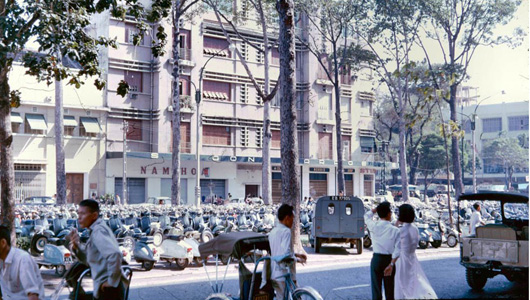 A parking lot full of Vespas and Lams
A parking lot full of Vespas and Lams
Lambretta bikes may look similar to Vespas, but their construction is different. The frame is made of welded iron tubes, and the engine is covered with an outer layer of sheet metal. In the 1960s, Lambretta bikes had a curved design. By the late 1960s and into the 1970s, the design became more straight and elegant, following the fashion trends of the time. Both Vespa and Lambretta bikes require manual gear shifting by pressing the clutch and turning to change gears.
Goebel, Sachs, Puch – German power
Since the late 1950s, the southern region also imported German motorbikes such as Goebel, Sachs, and Puch. These bikes shared common features such as fuel tanks placed in front of the rider, manual gear shifting, front and rear suspensions, and 50cc engines that classified them as vélomoteur without the need for a driver’s license.
Each bike had its own unique features. Puch bikes were always enclosed in an aluminum casing with a running fan for cooling. This allowed the engine to stay cool even when idle. As they were geared bikes, although with only 50cc engines, German motorbikes had more power than Mobylette bikes in gears 1 and 2. They were also used to tow carts with up to four passengers and cargo. Puch and Sachs still exist today.
>> Part 2: What did people in Saigon ride before 1975? (Part 2)
Thế Đạt (According to PL&XH)


























